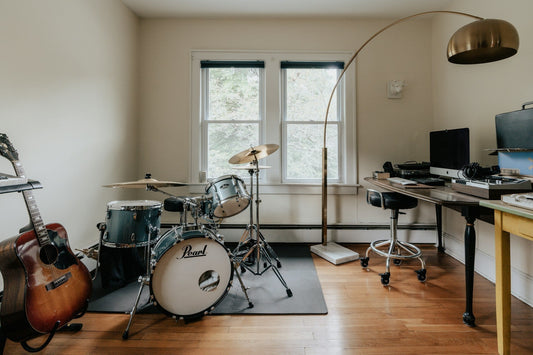
What is the Circle of Fifths: The Ultimate Guide for Home Studio Musicians
Partager
The circle of fifths is your creative cheat code for instant chord progressions, smooth key changes, and professional-sounding music—and you can start using it in the next five minutes.
This visual "musical clock" shows relationships between all 12 keys.
By understanding three simple patterns—adjacent keys share the most notes, clockwise movement adds sharps, and the inner circle shows relative minors—you'll unlock the same harmonic knowledge that top producers credit with transforming their compositions.
Whether you're stuck on a chord progression, want to transpose a song, or need to understand why certain chords sound good together, the circle of fifths provides immediate answers.
What is the circle of fifths?
Think of the circle of fifths as a clock face where C major sits at 12 o'clock with zero sharps or flats.
Moving clockwise, each "hour" adds one sharp (G at 1 o'clock has F#, D at 2 o'clock has F# and C#), while counterclockwise movement adds flats. This isn't random—it represents the strongest harmonic relationship in music after the octave, based on a 3:2 frequency ratio that our ears naturally find pleasing.
Here's what makes it immediately useful: adjacent keys on the circle differ by only one note, making them perfect for smooth chord progressions.
When you play C-F-G (the classic I-IV-V), you're actually moving one step counterclockwise to F, then two steps clockwise to G. This pattern works in every key—if you know one progression, the circle shows you how to play it in all 12 keys instantly.
The inner circle displays each key's relative minor, sharing the exact same notes but starting from a different point, giving you 24 harmonic options from one simple diagram. Am (A minor) sits inside C major because they use identical notes—no sharps, no flats—just different starting points that create entirely different emotional landscapes.

How to use the circle of fifths in three steps
Step 1: Master the adjacent key rule
The most powerful circle technique is moving to adjacent keys for smooth chord progressions. Pick any chord as your starting point, then move one step clockwise or counterclockwise for your next chord.
From C major, move counterclockwise to F major, then clockwise past C to G major. You've just played the foundation of thousands of songs—the I-IV-V progression (C-F-G). This works from any starting position: try Am-Dm-G or E-A-B.
If you’re familiar with colour theory in art and photography, this is a very similar process to colour harmony.
Step 2: Use the inner circle for instant emotional shifts
Every major key has its relative minor directly inside it on the circle, sharing identical notes but creating completely different moods.
When you're in C major (bright, uplifting), switch to its relative minor Am (melancholy, introspective) without changing any notes—just shift your starting point. For example, play C-F-G-Am. That final Am chord transforms the entire progression from major resolution to minor yearning, using the same notes but landing somewhere emotionally different.
Step 3: Quick transposition for any key
To transpose any progression, simply move every chord the same distance around the circle.
Take the classic vi-IV-I-V progression: Am-F-C-G. To play it in the key of A major, move everything three steps clockwise: F#m-D-A-E. The pattern stays identical; only the starting position changes. This technique works for any progression in any key—once you know a chord sequence, the circle shows you how to play it everywhere else instantly.
How professional producers actually use the circle in their workflow

Professional producers treat the circle of fifths as their harmonic GPS for navigating chord progressions.
The classic ii-V-I progression in jazz (Dm7-G7-Cmaj7) literally follows the circle counterclockwise, creating that satisfying resolution jazz musicians love.
Pop producers use the I-vi-IV-V progression (C-Am-F-G) which combines circle movement with the relative minor relationship, appearing in hundreds of hit songs from "Stand By Me" to "Someone Like You."
Electronic music producers apply the circle through harmonic mixing, using the Camelot Wheel (a DJ-friendly version) to ensure smooth transitions between tracks. Adjacent keys on the circle mix seamlessly because they share so many notes—mixing a song in C major with one in G major preserves harmonic coherence even as energy shifts.
For key modulation, producers jump around the circle strategically. Moving one step creates subtle shifts perfect for verse-to-chorus transitions. Moving two or three steps adds dramatic tension to bridges. Jumping to the opposite side (like C to F#) creates maximum contrast for emotional impact.
In my experience producing across multiple genres, I've found that basslines following circle patterns (like the ascending fifths in "Hey Joe": C-G-D-A-E) create powerful forward motion. Adding harmony parts a fifth above or fourth below (adjacent circle positions) ensures rich, consonant layers.
Start using the circle immediately with these exercises
 Exercise 1: The adjacent key workout (5 minutes)
Exercise 1: The adjacent key workout (5 minutes)
Start with any major chord and practice moving to its circle neighbours. From C major, play F major (one step counterclockwise) and G major (one step clockwise). These three chords give you countless song possibilities.
Now shift your starting point—from G major, play C and D. From D major, play G and A. Within minutes, you'll internalize how adjacent keys create smooth progressions in any key.
Exercise 2: The instant transposition technique (10 minutes)
Take a simple progression like C-Am-F-G. Using the circle, transpose it to G major by moving everything five steps clockwise: G-Em-C-D. Try it in D: D-Bm-G-A. The pattern remains identical; only the starting position changes.
This single skill will save you hours of trial-and-error transposition.
Exercise 3: The producer's progression builder (15 minutes)
Create a four-chord progression using only adjacent circle positions. Start anywhere and move only to neighbouring keys. From Am: Am-Dm-G-C creates a moody progression perfect for introspective verses. From E: E-B-F#-C# builds an energetic sequence ideal for uplifting choruses.
Limiting yourself to adjacent keys guarantees harmonic coherence while encouraging creativity within constraints.
Why your room acoustics matter for learning music theory
 Here's something most music theory guides overlook: you need to actually hear these relationships to internalize them.
Here's something most music theory guides overlook: you need to actually hear these relationships to internalize them.
Understanding the circle of fifths becomes infinitely easier when you can actually hear the relationships it describes.
In an untreated room, standing waves might boost specific frequencies while nulling others, making it impossible to hear the subtle differences between adjacent keys.
Flutter echoes can mask the smooth voice leading that makes circle-based progressions so satisfying.
When your space has proper acoustic treatment—typically 4-6 panels covering the first reflection points to your left, right, and behind your listening position—you create an environment where harmonic relationships become clearly audible. The goal isn't a completely dead room, but a balanced acoustic environment that lets you hear direct sound clearly while controlling problematic reflections.
Wrapping up
The circle of fifths distills centuries of musical evolution into one elegant diagram. Use it like a musical GPS—for chord progressions, transpositions, and answering every creator's burning question: "What chord comes next?"
Start with the three basic principles. Practice adjacent key exercises. Begin transposing today. The circle works best when you can actually hear the relationships it reveals—clear acoustics help you catch the subtle harmonic connections.
Ready to hear these relationships with crystal clarity?
AudioSilk's acoustic panels are designed for home studios—because understanding music theory is easier when your room isn't fighting against your ears.
Tag us on Instagram @audiosilkco with your transformation.



